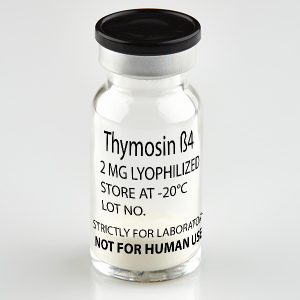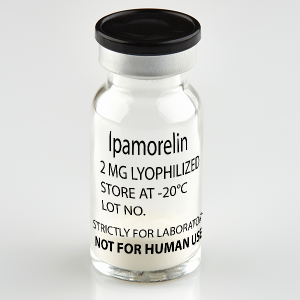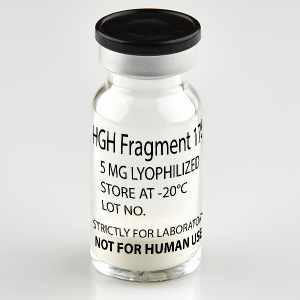Peptide Blog
Thymosin alpha-1 is a naturally occurring peptide fragment that was discovered in 1972. It has since been studied in clinical trials for cystic fibrosis, infection (e.g. tuberculosis, cytomegalovirus), respiratory disorders, chronic hepatitis, and cancer. It is currently approved for use in fighting chronic hepatitis B and C infections in 35 under-developed nations.
Tesamorelin, also called Egrifta in the clinical setting, is a growth hormone releasing hormone (GHRH) analogue consisting of standard GHRH to which an additional trans-3-hexanoic acid group has been added. Produced by Theratechnologies of Canada, Tesamorelin became the newest drug to be approved by the FDA for use in HIV-associated lipodystrophy in 2010. The peptide has also been investigated for its ability to improve peripheral nerve regeneration and as a potential intervention for mild cognitive impairment (MCI), the precursor to dementia.
TB-500 is a derivative and synthetic analogue of thymosin beta-4 (TB-4), which is found naturally in nearly all mammalian cells. TB-500 is known for its effects on actin protein, cell migration, and wound healing. TB-500 has been shown in animal models and in vitro studies to improve blood vessel growth, accelerate wound healing, decrease inflammation, and promote extracellular matrix production. The peptide is under current investigation for its ability reduce oxidative stress in spinal cord injury, improve recovery following heart attack, and for its many anti-aging effects.
TB-500 is the active domain of TB-4, which has a primary role as an actin binding protein. Actin is a critical component of cell structure and makes up microfilaments. Microfilaments are responsible for giving cells their shape, protecting the integrity of cell membranes, allowing cells to move/migrate, and certain steps in cellular reproduction. Actin is also one of the primary components of muscle protein. Without actin, muscles could not contract. Actin binding proteins, like TB-4, sequester actin monomers, the individual units of actin, so that they are protected from degradation and are available for polymerization into microfilaments when needed.
Sermorelin is one of a handful of growth hormone releasing hormone GHRH analogues that have been developed in recent years in an effort to preserve some of the positive effects of natural GHRH while avoiding undesirable effects. Sermorelin (Geref) is currently used clinically to assess growth hormone secretion, but the peptide is of additional interest for its abilities to:
- reduce scarring following heart attack,
- increase bone density,
- improve nutrition in chronic illness,
- improve renal function,
- fight the effects of dementia, and
- reduce seizure activity.
Selank, which was developed in Russia, is a short peptide with nootropic and anxiolytic properties. It is a synthetic analogue of naturally occurring Tuftsin, an immunomodulatory peptide that modulates IL-6, T helper cells, monoamine neurotransmitters, and brain-derived neurotropic factor (BDNF). In fact, Selank and Tuftsin are essentially the same except that Selank has an additional four amino acids in its chain that help to improve metabolic stability and half-life.
Selank has been tested in clinical trials as a potential treatment for generalized anxiety disorder.
Pegylated Mechano-growth factor (PEG-MGF) is a truncated and slightly altered form of insulin-like growth factor 1 (IGF-1). Research shows that it stimulates myoblast (muscle cell) proliferation and differentiation. It has also been explored in research focused on increasing endurance, boosting the function of the immune system, lowering cholesterol, and reducing total body fat. There is also some evidence to suggest that PEG-MGF improves immune function related to healing and could therefore less the time it takes for wounds to heal.
Semax is a synthetic analogue of adrenocorticotropic hormone (ACTH). It consists of the amino acids 4-10 of ACTH.
Semax, which was developed in Russia, has been found to have benefit in the settings of stroke, cognitive impairment, dementia, and inflammation of the optic nerve. It has also been tested as a potential immune system booster and has been found to have antidepressant and anxiolytic properties as well. Research shows that Semax increases levels of brain-derived neurotrophic factor (BDNF) in the central nervous system as well as levels of serotonin and dopamine.
Modified GRF (1-29) is a peptide analogue of growth-hormone-releasing hormone (GHRH). Modified GRF was first developed in the 1980s when it was discovered that the first 29 amino acids of GHRH retained all of the properties of the full 44-amino-acid protein. The original protein, called GRF (1-29), is the smallest fragment of GHRH that retains all of the properties of GHRH. Another truncated synthetic form of GHRH called Sermorelin or GRF 1-29 has 29 amino acids; Modified GRF (1-29) is further modified in that it has four substituted aminos in its chain that serve the purposes of preventing degradation and oxidation in manufacture and transport as well as in vivo, while also increasing binding affinity to the GHRH receptors.
Though GRF had full effect, the duration of action was limited due to a very short half-life (less than 10 minutes). As a result, researchers modified GRF (1-29) to give it a longer half-life and thus greater therapeutic potential. Modified GRF (1-29) is occasionally referred to as mod GRF or tetrasubstituted GRF (1-29). The latter name makes it clear that mod GRF differs from GRF (1-29) as a result of four amino acids being changed. Modified GRF (1-29) is identical to CJC-1295 without DAC.
MGF is a splice variant of insulin-like growth factor-1 (IGF-1). MGF is therefore a naturally occurring peptide, though it can be produced synthetically. It has been discovered to play important roles in tissue growth, wound healing, cardiac repair, and more. It is especially important to muscle repair following injury, after weight training, and in the setting of disease. The peptide has increasingly been of interest in research circles for its ability to protect against mechanical overload and lead to healing in otherwise-slow-to-heal tissues like cartilage.
Ipamorelin is a short peptide sequence capable of binding to the ghrelin/growth hormone secretagogue receptor. It is one of the most selective growth hormone (GH) secretagogues known and has been shown in laboratory studies to have no effect on ACTH, prolactin, follicle-stimulating hormone, luteinizing hormone, thyroid-stimulating hormone, or cortisol release [1]. Given its high level of specificity, ipamorelin has been of interest in research both as a therapeutic in and of itself as well as a model peptide for understanding how selectivity in receptor binding is achieved.





